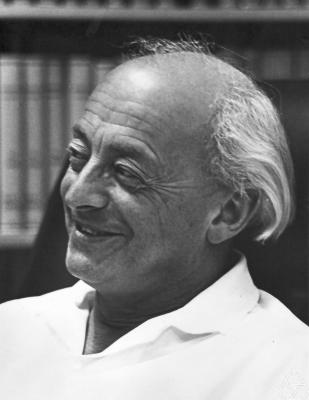Related Research Articles
In mathematics, an amenable group is a locally compact topological group G carrying a kind of averaging operation on bounded functions that is invariant under translation by group elements. The original definition, in terms of a finitely additive measure on subsets of G, was introduced by John von Neumann in 1929 under the German name "messbar" in response to the Banach–Tarski paradox. In 1949 Mahlon M. Day introduced the English translation "amenable", apparently as a pun on "mean".
Norm, the Norm or NORM may refer to:
In mathematics, specifically group theory, a subgroup series of a group is a chain of subgroups:

Reinhold Baer was a German mathematician, known for his work in algebra. He introduced injective modules in 1940. He is the eponym of Baer rings and Baer groups.
In projective geometry, a homography is an isomorphism of projective spaces, induced by an isomorphism of the vector spaces from which the projective spaces derive. It is a bijection that maps lines to lines, and thus a collineation. In general, some collineations are not homographies, but the fundamental theorem of projective geometry asserts that is not so in the case of real projective spaces of dimension at least two. Synonyms include projectivity, projective transformation, and projective collineation.

In mathematics, the lattice of subgroups of a group is the lattice whose elements are the subgroups of , with the partial ordering being set inclusion. In this lattice, the join of two subgroups is the subgroup generated by their union, and the meet of two subgroups is their intersection.
In mathematics, in the field of group theory, a subgroup of a group is termed a retract if there is an endomorphism of the group that maps surjectively to the subgroup and is the identity on the subgroup. In symbols, is a retract of if and only if there is an endomorphism such that for all and for all .
In mathematics, a slender group is a torsion-free abelian group that is "small" in a sense that is made precise in the definition below.
In mathematics, in the realm of group theory, a group is said to be capable if it occurs as the inner automorphism group of some group. These groups were first studied by Reinhold Baer, who showed that a finite abelian group is capable if and only if it is a product of cyclic groups of orders n1, ..., nk where ni divides ni +1 and nk −1 = nk.
In mathematics, George Glauberman's Z* theorem is stated as follows:
Z* theorem: Let G be a finite group, with O(G) being its maximal normal subgroup of odd order. If T is a Sylow 2-subgroup of G containing an involution not conjugate in G to any other element of T, then the involution lies in Z*(G), which is the inverse image in G of the center of G/O(G).

In mathematics, specifically in abstract algebra, a torsion-free abelian group is an abelian group which has no non-trivial torsion elements; that is, a group in which the group operation is commutative and the identity element is the only element with finite order.
In the theory of Riemann surfaces and hyperbolic geometry, the triangle group (2,3,7) is particularly important for its connection to Hurwitz surfaces, namely Riemann surfaces of genus g with the largest possible order, 84(g − 1), of its automorphism group.
In group theory, a branch of mathematics, the Nielsen–Schreier theorem states that every subgroup of a free group is itself free. It is named after Jakob Nielsen and Otto Schreier.
In mathematics, in the field of group theory, the Baer–Specker group, or Specker group, named after Reinhold Baer and Ernst Specker, is an example of an infinite Abelian group which is a building block in the structure theory of such groups.
In mathematical finite group theory, the Baer–Suzuki theorem, proved by Baer (1957) and Suzuki (1965), states that if any two elements of a conjugacy class C of a finite group generate a nilpotent subgroup, then all elements of the conjugacy class C are contained in a nilpotent subgroup. Alperin & Lyons (1971) gave a short elementary proof.
In mathematics, a Baer group is a group in which every cyclic subgroup is subnormal. Every Baer group is locally nilpotent.
Aracne was an Italian publishing company, founded in 1993 by Gioacchino Onorati and specialized in academic and scientific literature. It was declared failed on the 6 of april, 2018.

Dieter Held is a German mathematician. He is known for discovering the Held group, one of the 26 sporadic finite simple groups.
Advances in Group Theory and Applications (AGTA) is a peer reviewed, open access research journal in mathematics, specifically group theory. It was founded in 2015 by the council of the no-profit association AGTA - Advances in Group Theory and Applications, and is published by Aracne.
References
- Baer, Reinhold (1934). "Der Kern, eine charakteristische Untergruppe". Compositio Mathematica. 1: 254–283.
- Schmidt, Roland (1994). Subgroup Lattices of Groups. Walter de Gruyter. ISBN 9783110112139.